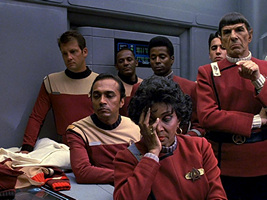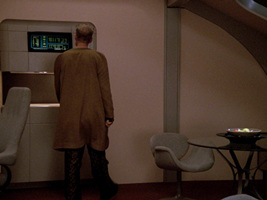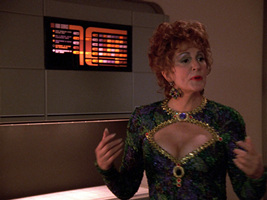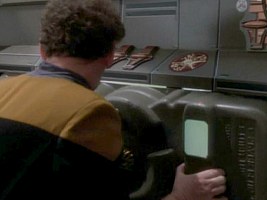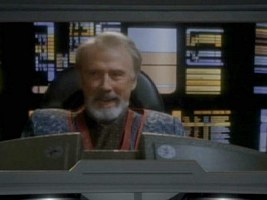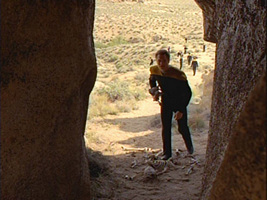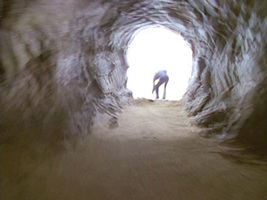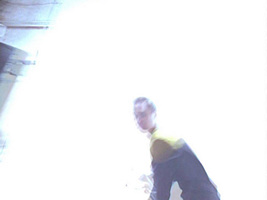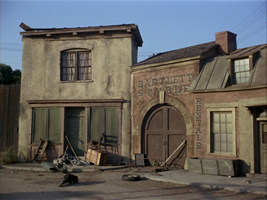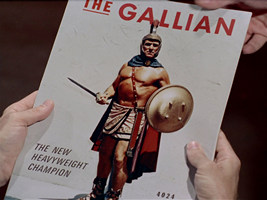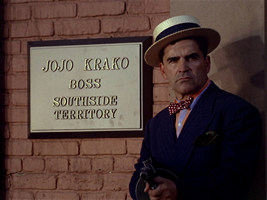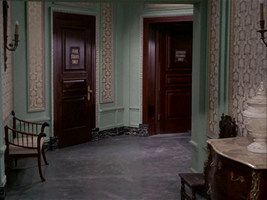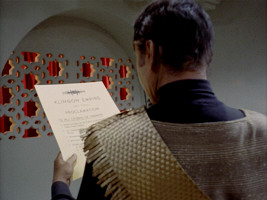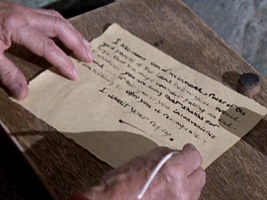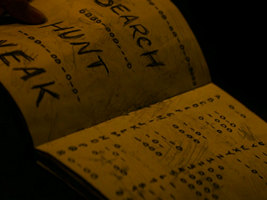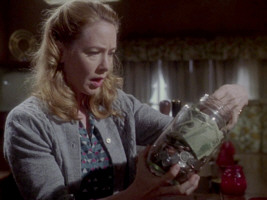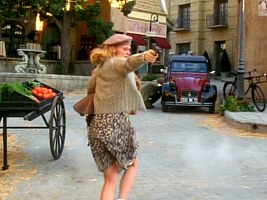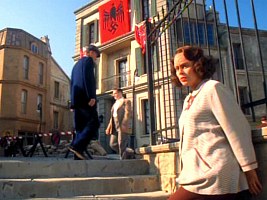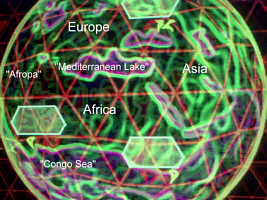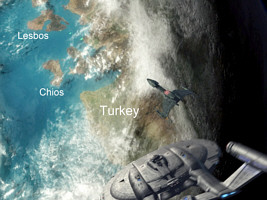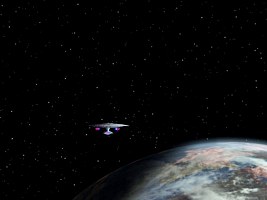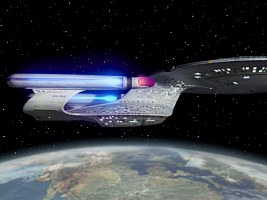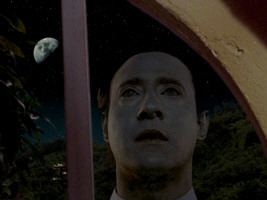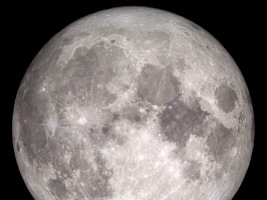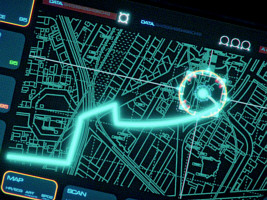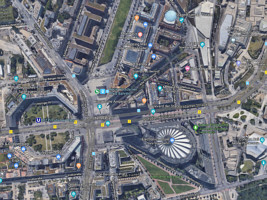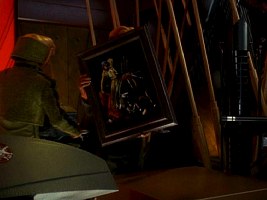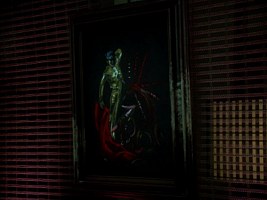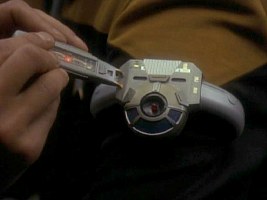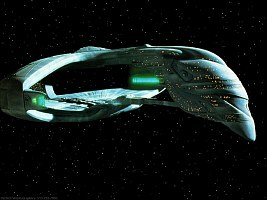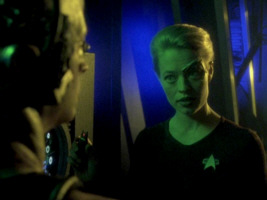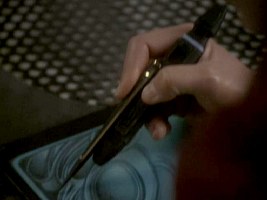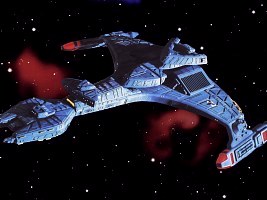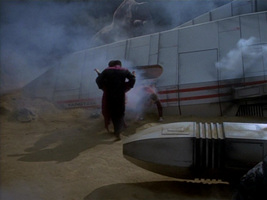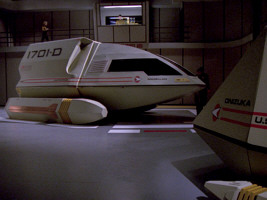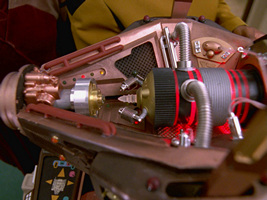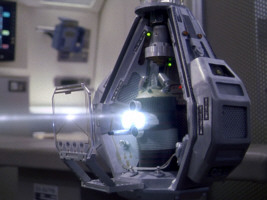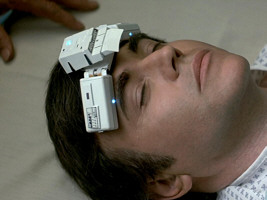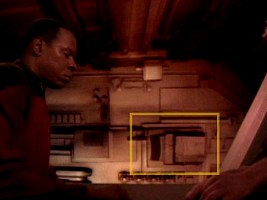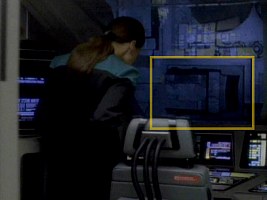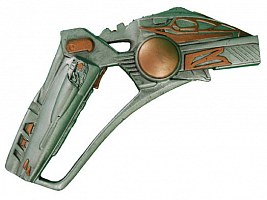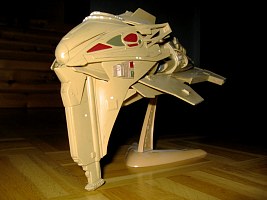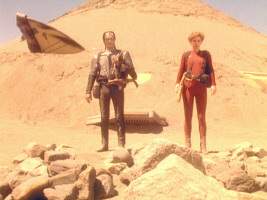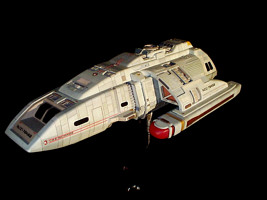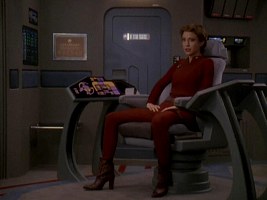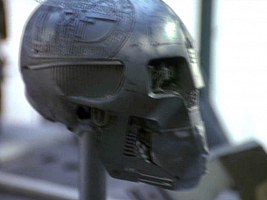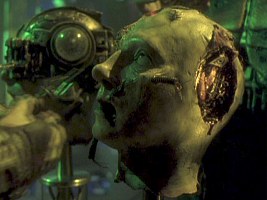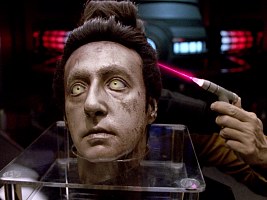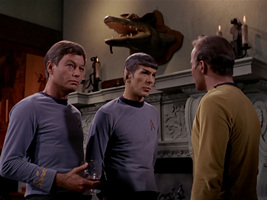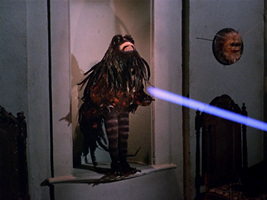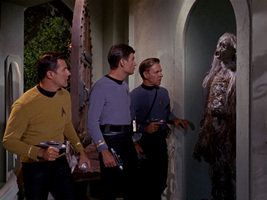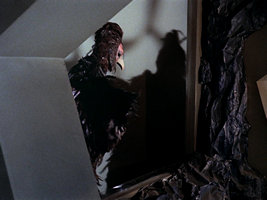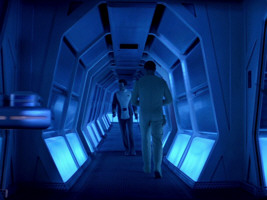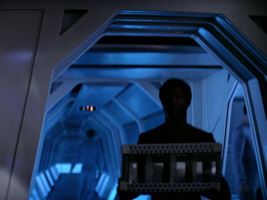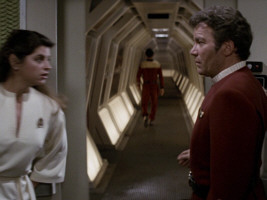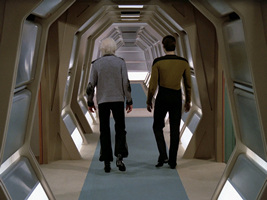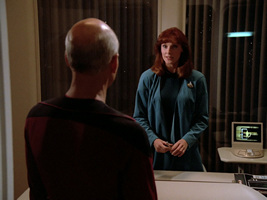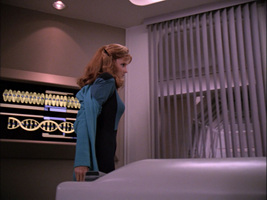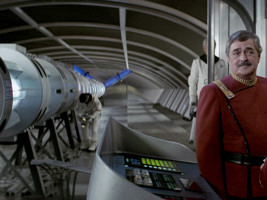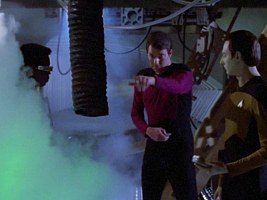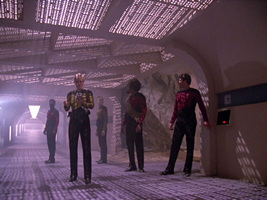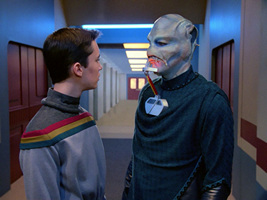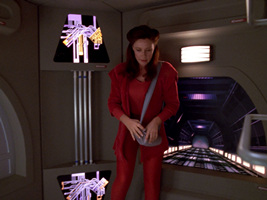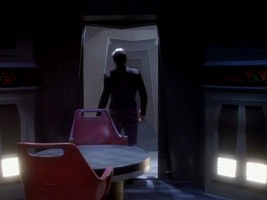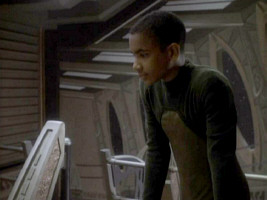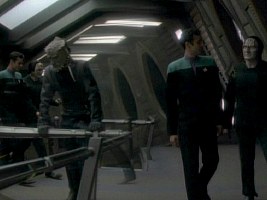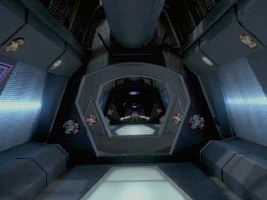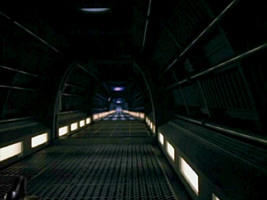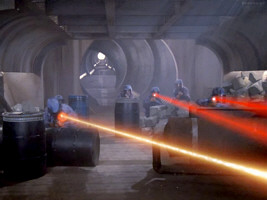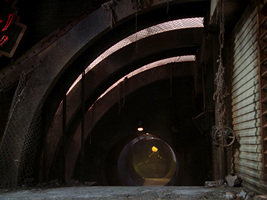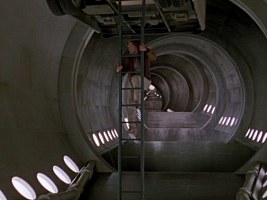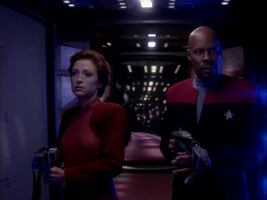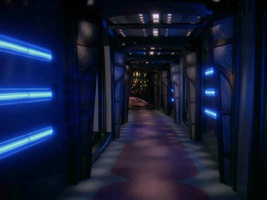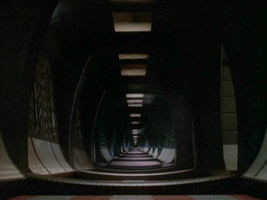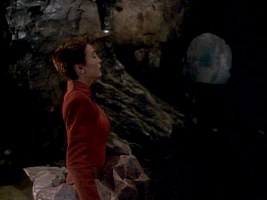Prop and Set Oddities
by Jörg Hillebrand and Bernd Schneider
Inconsistent Props or SetsOther Odd Props or Sets
A prop or a set in a TV or movie production is not supposed to work like the real thing, it only has to look authentic. Sometimes, however, we can notice that there is something wrong with it, or it looks strangely familiar when it shouldn't. Please take the following pictures with a grain of salt. It is not our intention to discuss the canonicity of odd props and sets.
Inconsistent Props or Sets
Anachronistic replicators
Many wall parts of the Enterprise-D from TNG were also used for the Enterprise-A of "Star Trek: The Undiscovered Country". Among them is the 24th century replicator. While it is already uncertain whether these devices existed at all in the 23rd century, we can find replicators not only in Captain Kirk's quarters, but even in the quarters of Crewman Dax (Chekov's main suspect at that time). Only the typical brownish TNG LCARS display was replaced with a blue/green version of the 23rd century to insinuate an older technology. When the replicators were transferred back to the Enterprise-D, however, the set builders obviously forgot to remove the 23rd century panels. We can see replicators with such old interfaces at the beginning of TNG season 5, in "A Matter of Time" and "Violations". Some time later in the 5th season the display was fixed.
Switched equipment
A Cardassian panel on Deep Space 9 in DS9: "Whispers" has Latin letters embossed on it. Vice versa, we can find a Cardassian console on a Federation shuttle in DS9: "Second Sight".
Speleology
Just before Hogan is devoured by a cave eel on Hanon IV in VOY: "Basics II", we can see him collect firewood in front of the cave whose entrance is rectangular and narrow. This was shot on location. The take which shows the perspective of the monster, on the other hand, was filmed in the studio, in order to be able to show a long camera move. Not only is the opening round here, the camera also moves out too far, showing a portion of the studio wall.
Alien English
English writing on alien planets was commonplace in TOS. We can see numerous instances of English signage or documents especially in the "parallel Earth" episodes "Miri", "Bread and Circuses", "A Piece of the Action", "Patterns of Force" and "The Omega Glory", with the apparent in-universe explanation that the similar development brought about the same language. This helped save costs because unchanged sets and signs could be used. It also facilitated the customary storytelling of the time because characters as well as viewers would know what is behind a door without it either being mentioned or kept a mystery. Only "The Return of the Archons" made an effort not to show English writing, which was accomplished by covering the signage of the 40 Acres set (but not the clock with Arabic numerals).
Another example of aliens writing in English in TOS is the Klingon proclamation in TOS: "Errand of Mercy". But at latest since TNG every alien civilization has its very own script, often with distinctive geometric shapes instead of letter-like symbols. There is one blatant exception: In VOY: "Blink of an Eye" we can see how the alien Protector writes a letter to the "Skyship" in English and signs it with "I await your reply".
 In SNW: "Memento Mori", La'an's brother Manu makes notes about the signals that the Gorn use to communicate. He finds out that this is a kind of Morse code for Latin letters A-Z, and for English words spelled with these very codes! So the conclusion is that the Gorn speak English! And that they use a primitive light code for their tactical communication, whose single pulses a human eye can distinguish and a boy can decipher on a piece of paper!
In SNW: "Memento Mori", La'an's brother Manu makes notes about the signals that the Gorn use to communicate. He finds out that this is a kind of Morse code for Latin letters A-Z, and for English words spelled with these very codes! So the conclusion is that the Gorn speak English! And that they use a primitive light code for their tactical communication, whose single pulses a human eye can distinguish and a boy can decipher on a piece of paper!
Future money for future technology
At the end of ENT: "Carbon Creek", T'Pol's grandma sells the idea of Velcro at a patent office. She receives a number of dollar bills that she puts into the tip jar of the bar in Carbon Creek. One $50 bill is a past-1997 design, as clearly indicated by the dark "50" on the bottom right of the reverse side.
Inaccurate simulation
In the simulation of the French town of Sainte Claire in "VOY: The Killing Game" we can see a Citroen 2CV6 Charleston in black and burgundy, clearly a model from the 1980s. But even the considerably different looking original 2CV did not exist prior to 1948, so the appearance of the car in a simulation of the Second World War is an error at any rate. Well, that wouldn't bother the Hirogen too much, just like the wrong Nazi emblems in the same simulation (such as a banner with a strangely disfigured eagle and a black swastika on red instead of white ground).
Weird geography
The map of a Klingon colony in ENT: "The Augments" is just a slightly modified Earth map, with Africa and Europe partially merged and a new ocean where the Congo Basin is supposed to be located. In a close-up of the Klingon planet shown during the battle in "Divergence" we can even make out the Turkish Aegean coast with the Greek islands of Lesbos and Chios.
 The same planet also appears in the remastered version of TNG: "Shades of Gray". It is seen from various angles in this episode, and we can confirm that not just the map but also the very CG model includes the alterations to the real Earth. Besides the already mentioned connection of Europe and Africa we can also see a partial outline of the Great Lakes, with parts of Ontario and New York submerged.
The same planet also appears in the remastered version of TNG: "Shades of Gray". It is seen from various angles in this episode, and we can confirm that not just the map but also the very CG model includes the alterations to the real Earth. Besides the already mentioned connection of Europe and Africa we can also see a partial outline of the Great Lakes, with parts of Ontario and New York submerged.
On a related note, the moon of Barkon IV in TNG: "Thine Own Self" looks strangely familiar. It is a picture of Earth's Moon, rotated 90 degrees counter-clockwise.
 Weird geography can also be found in Star Trek Discovery. In "Into the Forest I Go" we can see a map of the Sarcophagus ship, which looks much like a street map. The octagonal structure on the left and the streets running radially away from it give away that this is based on a map of Berlin. The octagonal square is Leipziger Platz, the area to the right is Potsdamer Platz. North is at the bottom.
Weird geography can also be found in Star Trek Discovery. In "Into the Forest I Go" we can see a map of the Sarcophagus ship, which looks much like a street map. The octagonal structure on the left and the streets running radially away from it give away that this is based on a map of Berlin. The octagonal square is Leipziger Platz, the area to the right is Potsdamer Platz. North is at the bottom.
Changeling painting?
It is quite common to re-use props, although in their second appearance they are supposed to represent something very different. Exactly the opposite happens with the painting of a matador that Morn purchases in DS9: "In the Cards". It is shown again in DS9: "Who Mourns for Morn", but although the arrangement is essentially the same, the different details reveal that is has been repainted, perhaps from scratch because the old version was not available any more.
Other Odd Props or Sets
Nacelle tools
The nacelle of an AMT Romulan Warbird kit acts as a scanner in DS9: "Visionary". Another nacelle scanner shows up in VOY: "Collective".
A Klingon Vor'cha engine can be seen as a brush in DS9: "Favor the Bold".
Speaking of nacelles, we can see what looks like the nacelle that was torn off the crashed runabout Yangtze Kiang in DS9: "Battle Lines". But the nacelle actually belongs to a Type-6 shuttlecraft.
Starship model parts
Not a nacelle, but the command section of an AMT model of the Klingon D7 battlecruiser was used for the interior of the exocomps in TNG: "The Quality of Life". When the prop reappears as an alien tool in ENT: "Dead Stop", the kit part is still present.
The central part of the medical device that McCoy applies to heal Chekov in "Star Trek IV" is the upper aft section of a Klingon K't'inga kit by AMT.
Parts of a K't'inga-class battlecruiser kit also appear in the Saratoga shuttlebay and aboard Deep Space 9, both in DS9: "Emissary".
Parts of a Kazon raider were incorporated into an alien pistol, which appeared in several episodes and eventually as a Vulcan weapon in ENT: "Kir'Shara". The partially green and red "ornament" and the engine casing can be seen on the pistol, probably taken from a Revell/Monogram model kit.
We can see the crashed Cardassian transport Ravinok in DS9: "Indiscretion", but the part in the sand behind Dukat is a phaser module of a Starfleet Danube class.
High-heeled hero
Seven of Nine is not the only Star Trek woman who emphasizes her unique qualities as an individual with high heels. We can see that Major Kira is wearing boots with heels of no less than 9 centimeters. If these boots are Bajoran militia standard issue, it is no surprise that it took them decades to defeat the Cardassians in the mountains of Bajor...
Silenced android
When B'Elanna is aboard the Pralor vessel to construct the prototype of a new "automated unit", we can see a couple of naked skulls without the metallic skin. These android skulls were probably not made for this very episode but are pieces of sculptural art. The problem: Pralor automated units do not have mouths with jaws and teeth. And so the according portion of the skull was simply covered with silver tape.
Databorg
You recognize one of the Borg heads on display in VOY: "Unimatrix Zero"? It is Data, more precisely the prop acting as his head in TNG: "Time's Arrow". Scary, isn't it?
Trelane's trophies
Trelane has a castle full of trophies in TOS: "The Squire of Gothos", some of which turn out quite silly as we watch more closely. Among them is an animal head that looks like a crocodile with pig ears glued on to make it look somehow alien. There is also a bird-like creature in something like a striped pantyhose. On the wall next to the bird we can notice a mask bearing a resemblance to the alien dog from TOS: "The Enemy Within" with three eyes, although it may be a different piece of fur. There is, however, one blatant re-use of a prop in the episode - the M-113 creature from TOS: "The Man Trap"! Trelane later vaporizes this creature as well as the bird with a phaser.
The bird, on the other hand, previously appeared in "The Cage", albeit in a different make-up. It was cut from "The Menagerie", which otherwise re-used almost the entire pilot episode. Probably the bird just looked bad.
Painted corridor extensions
Occasionally the illusion of a much more spacious set needs to be created, and the set designers resort to perspective matte paintings. In some cases these flat pictures are easily recognizable as such.
Painted corridor extensions are used on the Enterprise sets in the first two Star Trek movies. Note on the screen cap with Kirk from "Star Trek I" that the angle isn't quite right. We look into the corridor with an offset from the left, while the extension is painted straight head-on.
The same painting from the TOS movies (with a fitting style, considering that the corridors on the two ships are the same as is the whole basic layout of the sets on Stage 9) was used in TNG: "Encounter at Farpoint" and later placed behind the window in Beverly's office on the Enterprise-D. It can be seen in only two episodes though, namely in "Man of the People" and "The Quality of Life". On all other occasions the sunblind is closed. In "Encounter at Farpoint" and only in this one episode, however, we could still see the stars through Beverly's window. This is odd, because even if we concede that somewhere on the ship there might be such a straight vertical window, the hull would need to form a strange cavity in the region of sickbay, considering that at least the right portion of this set (as seen from the main entrance) would have to be farther outside. Most likely someone noticed this obvious error and decided that, rather than behind a window as it doesn't exist on the ship, sickbay should be located somewhere deeper inside the hull.
A corridor extension that originally appeared in main engineering aboard the USS Enterprise in "Star Trek: The Motion Picture" and "Star Trek II: The Wrath of Khan" was re-used for the Batris in TNG: "Heart of Glory".
A quite obvious painting can be seen behind Wesley and the Benzite in TNG: "Coming of Age". More extensions appear in TNG: "Datalore" and in DS9: "A Man Alone". On some other occasions the quality of the painting is very good, yet it is shown at the wrong angle such as in TNG: "Lessons". The same happens in DS9: "Babel" and more obviously in DS9: "The Search II" where the rearmost portion of the upper promenade deck seems to run down into the floor. In DS9: "Whispers" the access tunnel on Deep Space 9 was extended using the matte painting of a Federation Jefferies tube (visible in the far center of the picture). Another extended Jefferies tube is visible in VOY: "The Killing Game II".
We can see the same tunnel extension in TNG: "Too Short a Season" and, a few years later, in "Legacy". This painting was originally made for the access tunnels inside the "Mega Maid" in "Spaceballs"!
Only a short curved corridor set with the entrance to a crew accommodation was built for DS9. Painted extensions could be placed on either end of this corridor segment. The so outfitted set is visible in DS9: "Captive Pursuit", "Playing God", "The Way of the Warrior I" and "Hard Time". In "The Way of the Warrior I", Kira and Sisko even stand directly in front of the painted wall.
A straight corridor that was visually extended can be seen in DS9: "Through the Looking Glass". We can see a cave with a painted extension, as it appears in several more episodes, in DS9: "Heart of Stone".
See Also
Present-Day Devices as Props - or: what else game consoles and composters are useful for
Visual Bloopers - funny mishaps and editing mistakes
Visual In-Jokes - deliberate in-jokes on displays and props
Credits
The D7 part in "Star Trek IV" was spotted by Jay Smith, another D7 part in DS9: "Emissary" by Babaganoosh, the runabout part by Radioman, the wrong 2CV by David Craggs and the anachronistic dollar bill by M. Lamers. Thanks to Descent, who suggested that the Pralor skulls are art, rather than props, and to satre and Lee for their contributions! Thanks also to Larry Nemecek, who pointed us to the bird in "The Cage". Special thanks to Dan Carlson for spotting the corridors in the "Mega Maid".






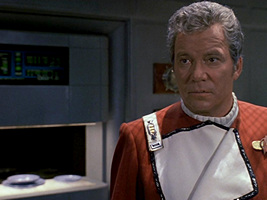
 24th century replicator in "Star Trek VI"
24th century replicator in "Star Trek VI"